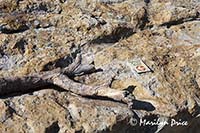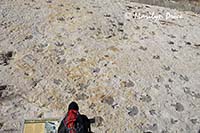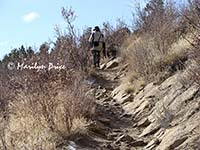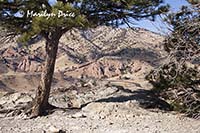Sept 22
Oct 1
Oct 6
Oct 20
Oct 27
Nov 3
Nov 17
Nov 23
Another Wednesday, another hike! We skipped last week because it was snowing! So, instead of a hike, we drove downtown to the Denver Museum of Nature and Science and spent a fascinating day wandering around there, including seeing a 3-D IMAX movie on the Hubble telescope, a tour of the galaxy in their planetarium, and several of the exhibit halls. We covered about half of the building. We’ll have to go back.
One of the exhibit halls was devoted to dinosaurs since Colorado has had many of these skeletons found here over the years, including a current dig in Snowmass. They’ve discovered some mastodons there recently.
So, is it any wonder that today’s hike has a dinosaur flavor? One of the hikes in the guide book I’ve been working my way through was for Dinosaur Ridge, near Golden, CO.
Yesterday was windy, cold, and very blustery. A nice day to stay inside by a fireplace. So, upon awakening this morning, we parted the curtains to see what kind of day this would be. Bright sunshine and calm. Ah, Colorado! It was still pretty chilly (only reached 40 by the time we headed back home), but not too bad.
We packed up and left home about our usual time. Traffic was heavier than usual with a couple of fender-benders slowing our progress, but we still arrived at the Visitor’s Center minutes before it opened at 9....
This was definitely not our usual hike. Most of the hike on their Ridge Loop was on a closed highway with informational signs to stop and read along the way.
Dinosaur Ridge is part of the Dakota Ridge formation which runs along the Front Range west of Denver. It’s called a hogback formation as it looks sort of like the back of a razorback hog. The layers of sandstone were upthrust almost vertically here and the softer layers on both sides have eroded more than this layer of sandstone, exposing dinosaur bones and tracks along both sides of this ridge.
The east side of this ridge has several spots to stop and look at the rocks exposed here. For example, the photo on the left shows an ancient seabed where the ripples caused by water movement have been frozen in time. The photo on the right shows where a tree branch was buried many millions of years ago. The branch subsequently dissolved and the cavity was filled with a softer material, which eroded faster than the surrounding rock, leaving a clear imprint of the branch. Someone has placed a modern branch into the cavity to call attention to it.
There was another section which had castings, which show the tunnels and burrows left by burrowing worms. They formed a wild pattern, but it was hard to capture in a photo.
The main draw for this trail is the very large field of dinosaur tracks that are on display. Here (left), Carl is looking at the sign with the many footprints spread before him. The tracks have been colored slightly, making them more visible. This area was a primary migration route in ancient times and the experts have labeled it a dinosaur “freeway”.
.
Near the top of this road, a trail branched off to the right, up towards the top of the hill. This is a section of the Dakota Ridge Trail, a six mile trail which intersected our trail. We were adventuresome, so we hiked along part of it - as far as the top of the ridge. The photo on the left is me on this fairly steep trail. The photo on the right shows one of the views from the top, looking west towards Mt. Morrison.
Not knowing where this trail went or how long it was (I looked it up later), we turned back at this point and returned to our original trail.
The road continued through a cut through the ridge (the photo on the left shows a tree clinging precariously to the exposed rocks of this cut) to the other side.
The west side of the ridge had two display stops. The first had more dinosaur tracks, but these were different (and hard to capture). The display showed some bulges in the sandstone layers that corresponded to the displacement of the layers made by brontosaurs as they walked on the mushy ground. Some of the displacements formed 6 inch displacements in the layers of sediment and indicated a very large foot - close to 18 inches in diameter.
The second display said it showed some dinosaur bones, but, if there hadn’t been signs pointing to them, we wouldn’t have found them. It didn’t look anything like I expected dinosaur bones to look like. Later, we learned that the upheavals in this area really fragment the bones and they are usually excavated in pieces. Putting them back together is like a jigsaw puzzle. One in the Visitor’s Center is missing a couple of pieces that just haven’t been found at all, despite years of searching.
We spent a couple of hours on this trail, which is fairly short, and some time in the Visitor’s Center, which has some very nice exhibits.
We had thought to continue on the Triceratops Trail in Golden to complete this day’s journey, but, after consulting the book again and seeing that this one had an even shorter write-up than the trail we just finished, we decided to call it a day and headed home. We were home in time for lunch...
It was an interesting visit, but I don’t think we’ll be repeating it.






